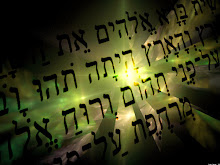The Religious Act: Asking the Question
The lesson of truth is not held in one consciousness. It explodes toward the other. To study well, to read well, to listen well, is already to speak: whether by asking questions and, in so doing, touching the master who teaches you, or by teaching a third party.”
--Emmanuel Levinas “Beyond the Verse: Talmudic Readings and Lectures” (1994)
Saturday, September 12, 2009
Characteristics of YHWH
My reading of Gunn and Fewell and the changing characters that can be found in a biblical narrative forced me to think critically about how "on the surface" I have read and even studied many a story in the Bible. Reading the bible in this way, I now realized, has made me to view God and his work in the world as always aiming for goodness. However, in reading the text, I was able to see how God, uses disasters and other situations in our lives as a means of bringing us in line with his will. How often in reading the stories that as Christians we allow ourselves to focus on the sad part of the stories without seeing how YHWH used these situations for his own purpose. In the story of Joseph, instead of looking on the horrific way in which the brothers treated Joseph, the authors suggest that the reader look at how YHWH used this situation as a way to cultivate in the brothers, and to us, an understanding of YHWH's power of salvation and redemption (p. 83). In the story of Ruth and Naomi, YHWH displays serveral characteristics - punisher, provider and savior. In the story Naomi loses her husband and sons and is mourning which might be seen as punishment for going to Moab in the first place but YHWH does not just through her to the wolves. Provision is made for her through the love and compassion that YHWh puts in the heart of her daughter-in-law Ruth who returns to Bethlehem with her. Inspite of being a foreigner in the land, Ruth who is not used to worshipping YHWH learns by the example of Naomi and is willing to learn how to worship YHWH and pledges that not even death will come between her and her mother-in-law. Finally, Ruth encounters Boaz by which YHWH shows his characteristic as savior.
My take-away from the assigned chapters in Narrative in the Hebrew Bible, forced me to recognize the importance of accepting YHWH's as complex, multi-faceted and challenging. Recognizing that all stories, even biblical one, are laiden with plots and twists with the characters in the story motivated by one or more things is a great way to look forward to what comes next in this interesting text.
Subscribe to:
Post Comments (Atom)

Who is YHWH?
ReplyDeleteIn reading Gunn and Fewell, Narrative in the Hebrew Bible, I have come to see YHWH in a different light. I am now in many ways more comfortable with the different and sometimes conflicting characters of YHWH. I am also in a better position to now embrace YHWH as almighty and powerful, YHWH as compassionate and caring, and YHWH as provider and punisher.
Gunn and Fewell revisited the story of Cain and Abel and showed how YHWH punished Cain for killing his brother by banishing him. However YHWH also saw it fit to protect him from harm and danger as he traveled to a strange land. In chapter 3, the authors discussed the story of Naomi and Ruth. On one hand Naomi described her situation as “YHWH’s hand in me”. Later on it was implied that blessed her and Ruth with Boaz.
This also made me think of YHWH as the negotiator who dialogues with Abraham about the possibility of saving Sodom and Gomorrah. He also seemed to listen to Moses about preserving the children of Israel even though they rejected Him and worshipped a golden calf.
I am comforted in the realization that YHWH is engaged in an ongoing relationship with us. Thus His character and the way He deals with us change as the circumstances of this relationship change. In the case Cain, his action made him a fugitive but YHWH’s action made him a success. In the case of Noami, her husband’s and son’s actions made her a widow without children, but YHWH’s action gave her a family again in the form of Ruth and Boaz.